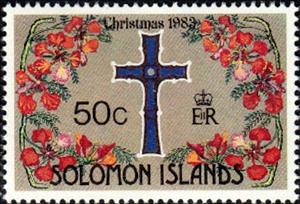Stamp: Cross, flowers (Solomon Islands 1983)
Cross, flowers (Solomon Islands 1983)
25 August (Solomon Islands ) within release Christmas 1983 goes into circulation Stamp Cross, flowers face value 50 Solomon Islands cent
| Stamp Cross, flowers in catalogues | |
|---|---|
| Michel: | Mi: SB 508 |
| Stamp Number: | Sn: SB 510 |
Stamp is horizontal format.
Also in the issue Christmas 1983:
- Stamp - Cross, flowers face value 50;
- Stamp - Wrestling face value 15;
- Stamp - Gilbertese (i-Kiribati) dancers face value 35;
- Stamp - Girl Dancers face value 18;
- Stamp - Malaitan pipers face value 40;
- Stamp - Weto dancers face value 12;
- Stamp - Temotu Devil dancers face value 20;
- Stamp - Bamboo Band face value 25;
- Stamp - Cross Surrounded by Flowers face value 50;
- Stamp - Custom Wrestling face value 15;
- Stamp - Devil Dancers face value 20;
- Stamp - Gilbertese Dancers face value 35;
- Stamp - Girl Dancers face value 18;
- Stamp - Girl Dancers face value 45;
- Stamp - Pan Pipers face value 40;
- Stamp - Weto Dancers face value 12;
|
Data entry completed
80%
|
|
|---|---|
| Stamp Cross, flowers in digits | |
| Country: | Solomon Islands |
| Date: | 1983-08-25 |
| Size: | 42 x 28 |
| Emission: | Commemorative |
| Format: | Stamp |
| Face Value: | 50 Solomon Islands cent |
Stamp Cross, flowers it reflects the thematic directions:
Christmas or Christmas Day (Old English: Crīstesmæsse, meaning "Christ's Mass") is an annual festival commemorating the birth of Jesus Christ, observed most commonly on December 25 as a religious and cultural celebration among billions of people around the world. A feast central to the Christian liturgical year, it is prepared for by the season of Advent or the Nativity Fast and initiates the season of Christmastide, which historically in the West lasts twelve days and culminates on Twelfth Night; in some traditions, Christmastide includes an Octave. The traditional Christmas narrative, the Nativity of Jesus, delineated in the New Testament says that Jesus was born in Bethlehem, in accordance with messianic prophecies; when Joseph and Mary arrived in the city, the inn had no room and so they were offered a stable where the Christ Child was soon born, with angels proclaiming this news to shepherds who then disseminated the message furthermore. Christmas Day is a public holiday in many of the world's nations, is celebrated religiously by the vast majority of Christians, as well as culturally by a number of non-Christian people, and is an integral part of the holiday season, while some Christian groups reject the celebration. In several countries, celebrating Christmas Eve on December 24 has the main focus rather than December 25, with gift-giving and sharing a traditional meal with the family.
A cross is a geometrical figure consisting of two intersecting lines or bars, usually perpendicular to each other. The lines usually run vertically and horizontally. A cross of oblique lines, in the shape of the Latin letter X, is termed a saltire in heraldic terminology.
A flower, sometimes known as a bloom or blossom, is the reproductive structure found in plants that are floral (plants of the division Magnoliophyta, also called angiosperms). The biological function of a flower is to effect reproduction, usually by providing a mechanism for the union of sperm with eggs. Flowers may facilitate outcrossing (fusion of sperm and eggs from different individuals in a population) or allow selfing (fusion of sperm and egg from the same flower). Some flowers produce diaspores without fertilization (parthenocarpy). Flowers contain sporangia and are the site where gametophytes develop. Many flowers have evolved to be attractive to animals, so as to cause them to be vectors for the transfer of pollen. After fertilization, the ovary of the flower develops into fruit containing seeds. In addition to facilitating the reproduction of flowering plants, flowers have long been admired and used by humans to beautify their environment, and also as objects of romance, ritual, religion, medicine and as a source of food.



